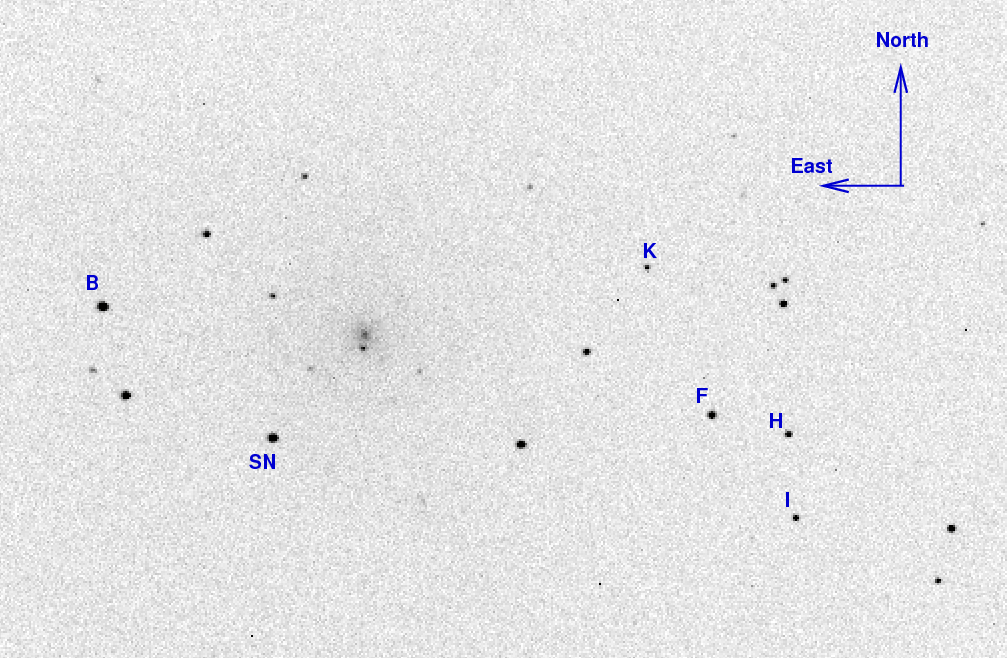
On the night of Sep 03/04, 2013, I observed SN 2013ej in M74, as well as the cataclysmic variable ASASSN-13ck. Conditions were very good: since I started at 2:30 AM, both objects were high in the sky. No clouds, no moon.
The main setup was:
Notes from the night
SN 2013ej is a Type II supernova in the relatively nearby galaxy M74. It was discovered by the KAIT group about one week before maximum light. Here's a chart showing the galaxy, the SN, and some reference stars:

The reference stars marked above have magnitudes in AAVSO chart 12459CA, as follows:
letter B sigB V sigV R sigR I sigI B 13.012 0.019 12.510 0.019 12.154 0.019 11.834 0.019 F 13.848 0.026 13.065 0.022 12.622 0.025 12.152 0.027 H 14.338 0.029 13.692 0.024 13.329 0.029 12.964 0.030 I 14.832 0.027 13.912 0.023 13.416 0.026 12.939 0.030 K 15.192 0.034 14.613 0.027 14.275 0.034 13.915 0.036
I took 30-second guided images in VRI, and on this night managed to guide (poorly) in B-band, too. After discarding the bad images, I was left with 7, 8, 12, and 7 images in B, V, R, and I, respectively.
Using aperture photometry with a radius of 4 pixels (radius of 7.4 arcsec), I measured the instrumental magnitudes of a number of reference stars and the target. Following the procedures outlined by Kent Honeycutt's article on inhomogeneous ensemble photometry, I used all stars available in each image to define a reference frame, and measured each star against this frame. I used the AAVSO magnitudes, plus color terms to convert the ensemble instrumental magnitudes to the standard Johnson-Cousins BVRI scale.
Results from this evening are:
filter mag mag_uncert Julian Date B = 14.406 +/- 0.039 (ens 0.031 zp 0.023) 2456539.79639 V = 13.164 +/- 0.026 (ens 0.016 zp 0.021) 2456539.78904 R = 12.686 +/- 0.019 (ens 0.013 zp 0.014) 2456539.78124 I = 12.446 +/- 0.030 (ens 0.015 zp 0.026) 2456539.80394
The uncertainties here are roughly equally distributed between extracting the instrumental magnitudes and transforming the instrumental magnitudes to the standard scale.
Grab the text file below for all the RIT measurements of SN 2013ej. All these values have been recomputed with the new color terms of UT 2013 Aug 05.

The All-Sky Automated Survey for Supernovae at Ohio State has found a number of interesting variable stars in addition to supernovae. You can read all about their "transients" at http://www.astronomy.ohio-state.edu/~assassin/transients.html . One of those is called "ASASSN-13ck", and is an interesting cataclysmic variable star.
RA = 00:11:33.71 Dec = +04:51:23
Here's a chart of the region from the DSS:

I took a series of 120-second V-band images of the field last night. One of our images is shown below: the field of view is about 15-by-10 arcminutes.
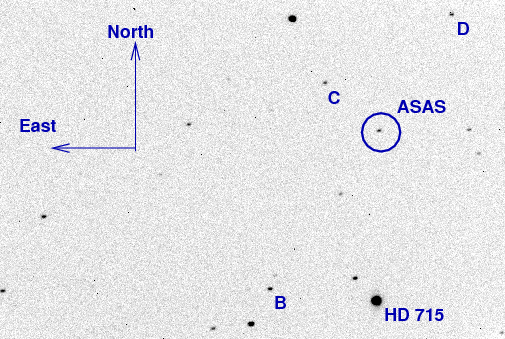
The stars marked "B", "C", and "D" have magnitudes provided by the AAVSO, in their sequence 12635FGO:
# # Report this sequence as: 12635FGO in the chart field of your observation report. # # AUID RA. Dec. my B V B-V Rc Ic 000-BLD-228 0:12:23.76 4:37:23.8 117 12.407 (0.081) 11.745 (0.056) 0.662 (0.098) 11.555 (0.419) 11.373 (0.590)29 000-BLD-229 0:11:35.97 5:01:27.5 122 12.839 (0.062) 12.183 (0.034) 0.656 (0.071) 11.998 (0.438) 11.820 (0.619)29 000-BLD-230 0:11:52.92 4:41:53.2 125 13.265 (0.090) 12.543 (0.049) 0.722 (0.102) 12.368 (0.432) 12.200 (0.609)29 000-BLD-231 0:12:16.60 5:01:36 127 13.304 (0.072) 12.696 (0.049) 0.608 (0.087) 12.490 (0.480) 12.293 (0.676)29 000-BLD-232 0:11:57.29 4:44:45.3 131 13.860 (0.081) 13.065 (0.056) 0.795 (0.098) 12.826 (0.446) 12.598 (0.628)29 000-BLD-233 0:11:47.66 4:46:26.2 B 136 14.235 (0.093) 13.603 (0.053) 0.632 (0.107) 13.411 (0.444) 13.226 (0.626)29 000-BLD-234 0:11:51.00 4:59:53.2 138 14.476 (0.086) 13.843 (0.052) 0.633 (0.100) 13.723 (0.461) 13.604 (0.650)29 000-BLD-235 0:11:24.39 4:55:00.5 D 141 15.140 (0.072) 14.146 (0.033) 0.994 (0.079) 13.613 (0.113) 13.116 (0.156)29 000-BLD-236 0:11:40.47 4:52:53.9 C 144 15.127 (0.082) 14.357 (0.048) 0.770 (0.095) 14.148 (0.469) 13.948 (0.662)29 000-BLD-237 0:11:35.79 4:57:58.4 147 15.780 (0.085) 14.693 (0.046) 1.087 (0.097) 14.304 (0.495) 13.939 (0.699)29 000-BLD-238 0:11:52.60 4:53:01.2 155 16.521 (0.112) 15.497 (0.045) 1.024 (0.121) 15.215 (0.379) 14.948 (0.534)29
Here's a view of the finder scope's field of view when the target was centered in the main telescope:
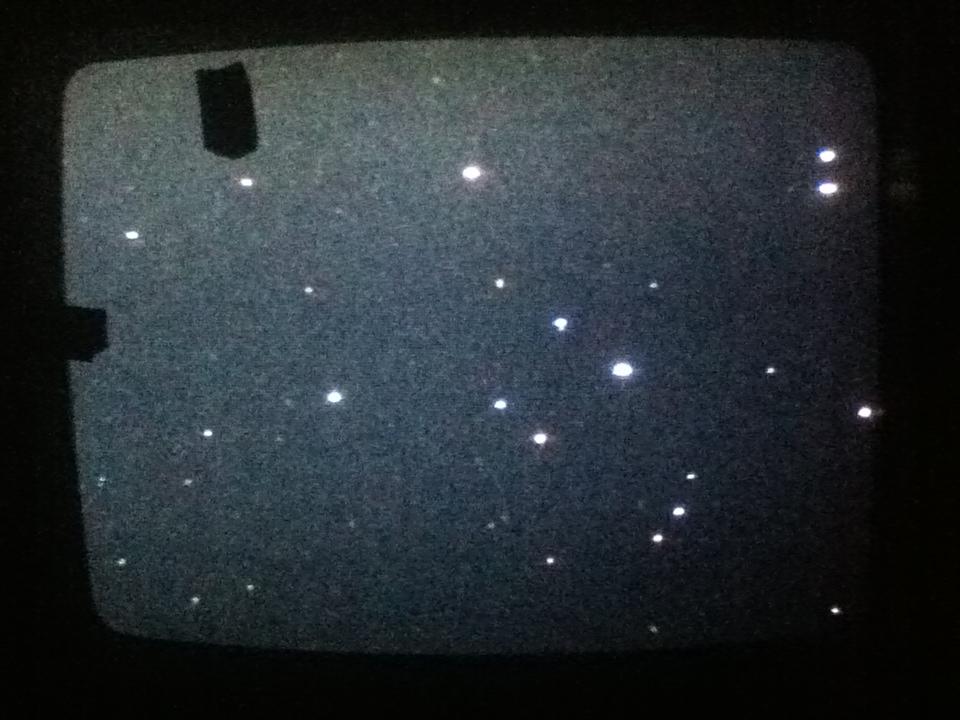
If we look at zero-point values versus time, we see a general increase as the object slid down the sky toward the western horizon, though it was always above airmass 2. There are a couple of outliers due to bad tracking.
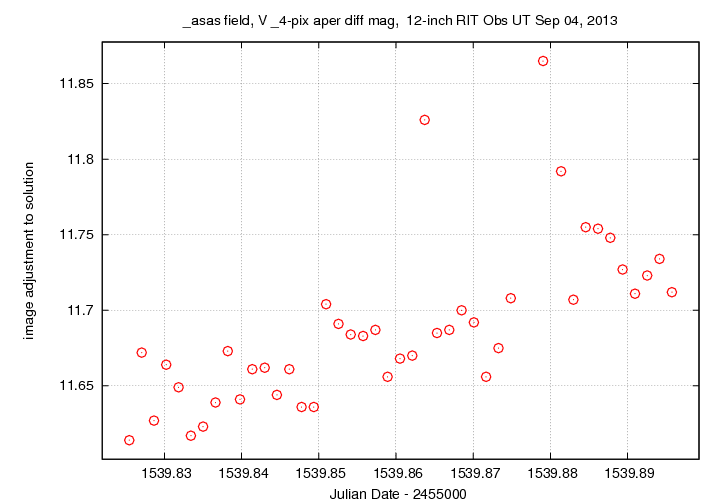
The bright star north of the variable star, above "C" in the picture above, is not saturated; but it is bright enough to dominate the ensemble solution. The variable is the slightly high point around instrumental mag 2.7.
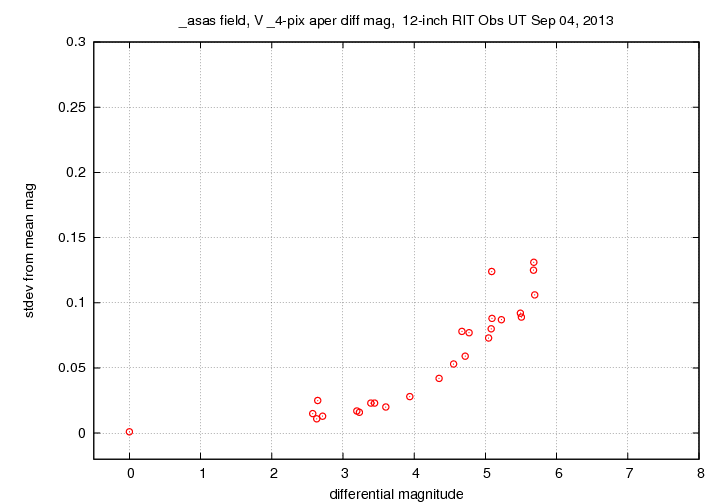
Here's a graph showing the variations in stars in the field; ASASSN-13ck is shown by green crosses.
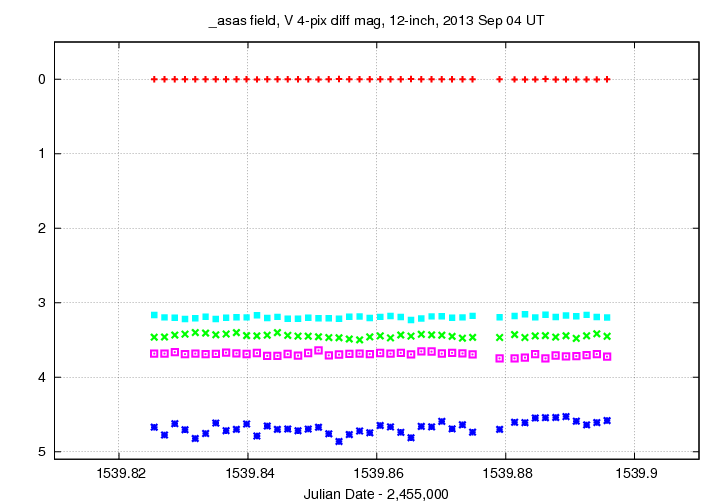
And here's a closeup of the variable and stars of similar brightness.
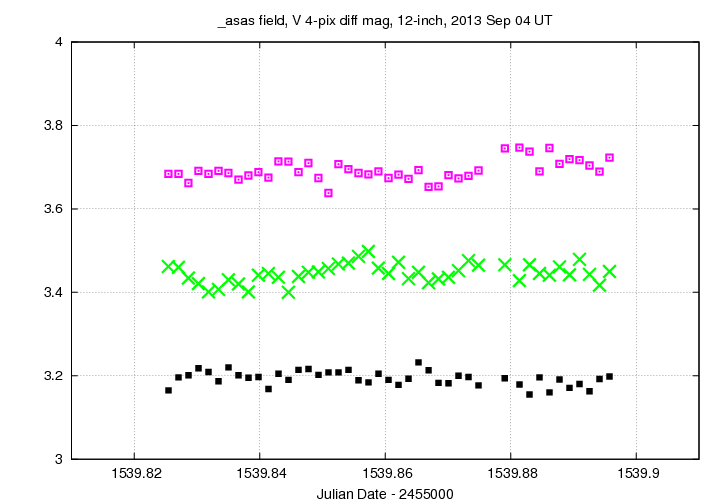
You can download my measurements from a file linked below. The first few lines of the are shown here for format.
# Measurements of ASASSN-13ck made at RIT Obs, Sep 4, 2013 UT, # in good conditions, # by Michael Richmond, using 12-inch Meade and SBIG ST-8E CCD. # Exposures 120 seconds long, V filter. # Tabulated times are midexposure (FITS header time - half exposure length) # and accurate only to +/- 1 second (??). # 'mag' is a differential magnitude based on ensemble photometry # using a circular aperture of radius 7.4 arcseconds. # which has been shifted so UCAC4 475-000306 has mag=14.357 # which is its V-band magnitude according to AAVSO. # # UT_day JD HJD mag uncert Sep04.32546 2456539.82546 2456539.83082 14.429 0.021 Sep04.32706 2456539.82706 2456539.83242 14.427 0.021 Sep04.32865 2456539.82865 2456539.83401 14.401 0.022
Last modified 09/04/2013 by MWR.